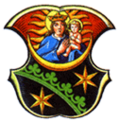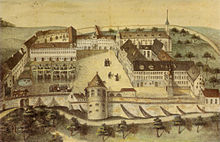Elchingen Monastery
|
Territory in the Holy Roman Empire |
|
|---|---|
| Imperial Abbey of Elchingen | |
| coat of arms | |
 ; ;
|
|
| map | |

|
|
| Territory of the Imperial Abbey of Elchingen consisting of two parts: Enclave in the Ulm city area (center, purple) and exclave on the Danube (southeast, sand-colored) | |
| Alternative names | Reichsstift |
| Arose from | rural abbey |
| Form of rule | Corporate state |
| Ruler / government | Reich Abbot |
| Today's region / s | DE-BY ; DE-BW |
| Parliament | Reichsfürstenrat : 1 curiate vote on the Swabian prelate bank |
| Reich register | 2 glaives (1422); 3 horses, 13 foot soldiers and 180 guilders (1521); 3 on horseback and 13 foot soldiers or 88 guilders (1663); 3 on horseback and 13 foot soldiers or 88 guilders, 90 guilders for the Supreme Court (1719) |
| Reichskreis | Swabian Empire |
| District council | County council; 6 on horseback and 26 on foot (1532); |
| Capitals / residences | Elchingen |
| Denomination / Religions | Roman Catholic |
| Language / n | German ; Latin |
| surface | 112 square kilometers (around 1800) |
| Residents | 4,000–4,200 (around 1800) |
| Incorporated into | 1803: Electorate of Bavaria ; 1810: Ulm part of the Kingdom of Württemberg
|
The monastery Elchingen (also Monastery Oberelchingen ) is a former Benedictine - Abbey in Oberelchingen in the diocese of Augsburg . It is dedicated to Saint Mary and Saint Peter and Paul . From 1921 to 2009 it was populated by Oblates of the Immaculate Virgin Mary .
Monastery history
The monastery was founded before 1120 in the valley near the Danube by Count Adalbert von Ravenstein (near Steinenkirch in the district of Göppingen ) and von Elchingen († around 1121) and his wife Berta von Boll .
After a fire, the monastery was re-established on the mountain within a medieval castle complex at its current location. The founders of the new establishment were Margrave Konrad von Meißen and his wife Luitgart (* around 1104, † around 1145), the daughter of the first founders Berta and Adalbert. A deed of foundation no longer exists. The consecration date is August 15, 1128, and 1142 elsewhere. In any case, in a document dated February 26, 1142, Konrad and Luitgard placed the monastery at Elchingen under the pope .
The abbey church, a Romanesque , three-aisled pillar basilica built on the Hirsau model , 60 meters long, was preserved in its original core despite the fire (1146) and structural changes. Almost all of the masonry dates from the early days of the company. The first monks' convent may also have come from Hirsau .
On September 24, 1150, the St. Blasien Monastery exchanged goods for Aralingen and Siggingen (meaning Kirchdorf AG , Nussbaumen AG and Baden AG ), with properties of the St. Blasien Monastery in the area near Elchingen: Ochsenbrunnen , Balheim , Diepertshofen and Libiu . The certificate was made in Nawen , Langenau in the presence of King Konrad III. as Vogt of the Elchingen Monastery.
Under the influence of the Melk monastery reform , the Benedictine Abbey of Elchingen flourished in the late Middle Ages.
From 1485 the abbey was directly part of the empire , and the abbot was represented as the imperial prelate in the diet of the Holy Roman Empire . Since then, Elchingen has belonged as an imperial abbey to the Swabian Prelate Bank of the Reichstag, where it took second place. Nevertheless, the free imperial city of Ulm had a right of supervision over the monastery and the jurisdiction in the villages belonging to the monastery. When Ulm converted to the Protestant faith , it left the monastery and its possessions largely unmolested and the monastery defied the influences of the Reformation. Abbot Andreas Dirrlin (1541–1547) was the first head of the Elchingen monastery to receive pontificals .
Devastation was to be lamented in the Schmalkaldic War of 1546, in the Margrave War of 1552 and in the Thirty Years' War . Since 1644 there has been a pilgrimage to the Virgin Mary of the Seven Sorrows, standing in the left wing of the monastery church, which was of national importance in the 17th and 18th centuries.
The convent building was built by the master builder Christian Wiedemann , who also built the abbey building of the Wiblingen monastery .
The eastern part of the old Romanesque abbey church of St. Peter and Paul from 1142 was destroyed by fire in 1773, and the tower collapsed. The reconstruction of the church from 1773 to 1784 under Abbot Robert I. Kolb coincided with the time when the architectural style was changing. The choir is in the Rococo style, while the nave, on the other hand, is designed in an early Classicist style. The builder was Joseph Dossenberger , Johann Michael Fischer designed the altars and the sculptures, Januarius Zick painted the altarpiece and the ceiling frescoes.
The twin towers could no longer be completed because the imperial abbey and the Benedictine monastery were dissolved in 1802 in the course of secularization and passed to Bavaria. Almost the entire monastery complex was demolished by 1840. Apart from the church, only the monastery wall and the west gate (Martinstor) are still standing today.
On October 14, 1805, the battle of Elchingen took place in the fields immediately north of the monastery complex , at which the armies of France and Austria clashed as part of the Third Coalition War . It was the largest battle of the Battle of Ulm , which practically decided the coalition war in Napoleon's favor. On the evening of that day Napoleon took quarters in the buildings of the Elchingen monastery.
In 1921, Oblates of the Immaculate Virgin Mary settled on the grounds . Due to a lack of young people, the monastery was handed over to the Polish Oblate Province in 2006.

Imperial Abbey of Elchingen
history
See the section on the history of the monastery above and the information in the box on the right in the Reichsabtei Elchingen box .
Administrative division
The administrative division of the territory of the Reich Abbey of Elchingen until its dissolution due to the Reichsdeputationshauptschluss of February 25, 1803 was as follows:
I. Oberamt Elchingen
- Elchingen Monastery, with the village of Oberelchingen
- Parish village Thalfingen
II. Fahlheim Nursing Office
- Unterfahlheim village
- Parish village Fahlheim ( Oberfahlheim )
- Parish village of Straß
- Village of Nersingen
- Share in the village of Leibi
- Glassenhardt farm
III. Nursing Office Stoffenried
- Parish village of Stoffenried
- Hausen village
- The Riedmühle
- Baldertshofen village
- 3 Sölden in Ettlishofen
- Share in the village of Schneckenhofen
IV. Tomerdingen Care Office
- Parish village Tomerdingen
- Parish village Westerstetten
- Parish village Dornstadt
- Weiler Vorderdenkental
- Hamlet Hinterdenkental
- The Birkhof near Westerstetten
List of abbots and imperial abbots
Abbots
- Andreas von Aichaim (1128–1138)
- Wilhelm (1138–1150)
- Hermann from Zwyfalten (1150–1180)
- Adalbert from Ursperg (1180–1215)
- Berthold (1215-1240)
- Heinrich (1240−?)
... (gap) ...
- Konrad I. von Roth (1326-1340)
- Hildebrand (1340-1360)
- Konrad II. Klotzer (1360-1385)
- Ulrich von Liechtenstein (1386–1424)
- Marx von Roth (1424-1426)
- Jakob Gossolt (1426–1431)
- Friedrich Zwirner (1431–1461, † 1465)
Imperial abbots
- Paul I. Kast (1461-1498)
- Johann I. Kirchlin (1498–1519, † 1521)
- Hieronymus Herzog (1519–1541)
- Andreas II. Dirlin (Dirrlin) (1541–1547) 1st infuled abbot
- Thomas I. Clauss (1547)
- Sylvester Gottfried (1547–1553, † 1573)
- Leonhard Mayer (1553–1555)
- Sebastian Eberlin (1555–1565, † 1570)
- Erhard Wassermann (1564–1581)
- Gallus Keppeler (1581–1602)
- Thomas II. Holl (1602-1619)
- Johann II Speigelin (1620–1638)
- Johann III. Treu (1639–1657, † 1662)
- Anselm Bauser (1657–1685)
- Meinrad Hummel (1685–1706)
- Cölestin Riederer (1706–1740)
- Amandus Schindele (1740–1763, † 1764)
- Gregor Pfeifer (1763–1766)
- Robert I. Kolb (1766-1793)
- Paul II. Gröbl (1793-1801)
- Robert II. Plerch (1801–1803, † 1810)
Personalities
- The Swabian Baroque composer Sixtus Bachmann was a pupil of the Elchingen Monastery from 1766–1771. He later entered the order of the Premonstratensians in the Marchtal monastery .
literature
- Anton Aubele: Elchingen Monastery. The Benedictine Abbey of Elchingen from the end of the Thirty Years War to secularization. Anton H. Konrad Verlag, Weißenhorn 2020, ISBN 978-3-87437-582-5 .
- Bernhard Brenner: The former Reichsstift Elchingen / Oberelchingen. In: Werner Schiedermair (Ed.): Klosterland Bavarian Swabia. Fink Verlag, Lindenberg 2003, ISBN 3-89870-127-1 , pp. 216-219.
- Albert Dirr: The Imperial Abbey of Elchingen from the middle of the 15th to the middle of the 16th century. Augsburg 1926 (also dissertation, University of Munich 1925).
- Franz Josef Hagel: Elchingen Monastery. Benno Filser, Augsburg 1928 (= German Art Guide Volume 18).
- Anton H. Konrad: The Reichsabtei Elchingen. Your image over the centuries. Anton H. Konrad Verlag, Weißenhorn 1965.
- Ferdinand Kramer : Science and Striving for "True Enlightenment". A contribution to the education in the East Swabian Benedictine monastery Elchingen. In: Journal for Bavarian State History. 54, 1991, ISSN 0044-2364 , pp. 269-286 ( digital-sammlungen.de ).
- Wolfgang Wüst : Spiritually commented on war, crises and catastrophes… Diaries and correspondence from southern German monasteries and parishes around 1800. In: Franz Brendle , Anton Schindling (Ed.): Clergy in War. Aschendorff Verlag, Münster 2009 (especially regarding the Elchingen Abbey in Napoleonic times), ISBN 978-3-402-12790-2 , pp. 203-224.
- Wolfgang Wüst: Dzienniki ze szwabskich klasztorów i probostw z okresu rewolucji francuskiej. Sa-moświadomość duchowieństwa w czasach kryzysu = diaries from Swabian monasteries and parishes in the age of the French Revolution. Clerical Self-Perception in Crisis. In: Bulletin of the Polish Historical Mission. 8, Toruń 2013, pp. 143–186, in particular the diaries / chronicles of the Elchingen Monastery. ISSN 2083-7755 .
- PL Brunner (Ed.): Fates of the Elchingen Monastery during the Thirty Years' War (1629–1645). From the diary of Father Johannes Bozenhart. ( books.google.com ).
- Article by Raiser In: Zeitschrift für Baiern and the neighboring countries. ( books.google.com ).
Web links
- More detailed history of the monastery from the House of Bavarian History (PDF; 49 kB)
- Parish of Oberelchingen
Individual evidence
- ↑ Heinz Bühler: On the history of the early Staufer , in: Walter Ziegler (Hrsg.): Hohenstaufen. Publications of the history and antiquity society Göppingen e. V. , 10th episode, 1977, pp. 1-44
- ^ A b c Elmar Theisen, Wladyslaw Poddebniak, Franz Walter, Karl Rösch: Oberelchingen. Parish and pilgrimage church of St. Peter and Paul. Passau 2008, ISBN 978-3-89643-721-1 , pp. 2-6.
- ↑ Martin Gerbert : Hist. Nigra Silva. Volume III, p. 76.
- ^ Journal for Bavaria and the neighboring countries. Volume 1, 1817, pp. 286 ff. ( Books.google.com ).
Coordinates: 48 ° 27 '8.5 " N , 10 ° 5' 17.2" E


